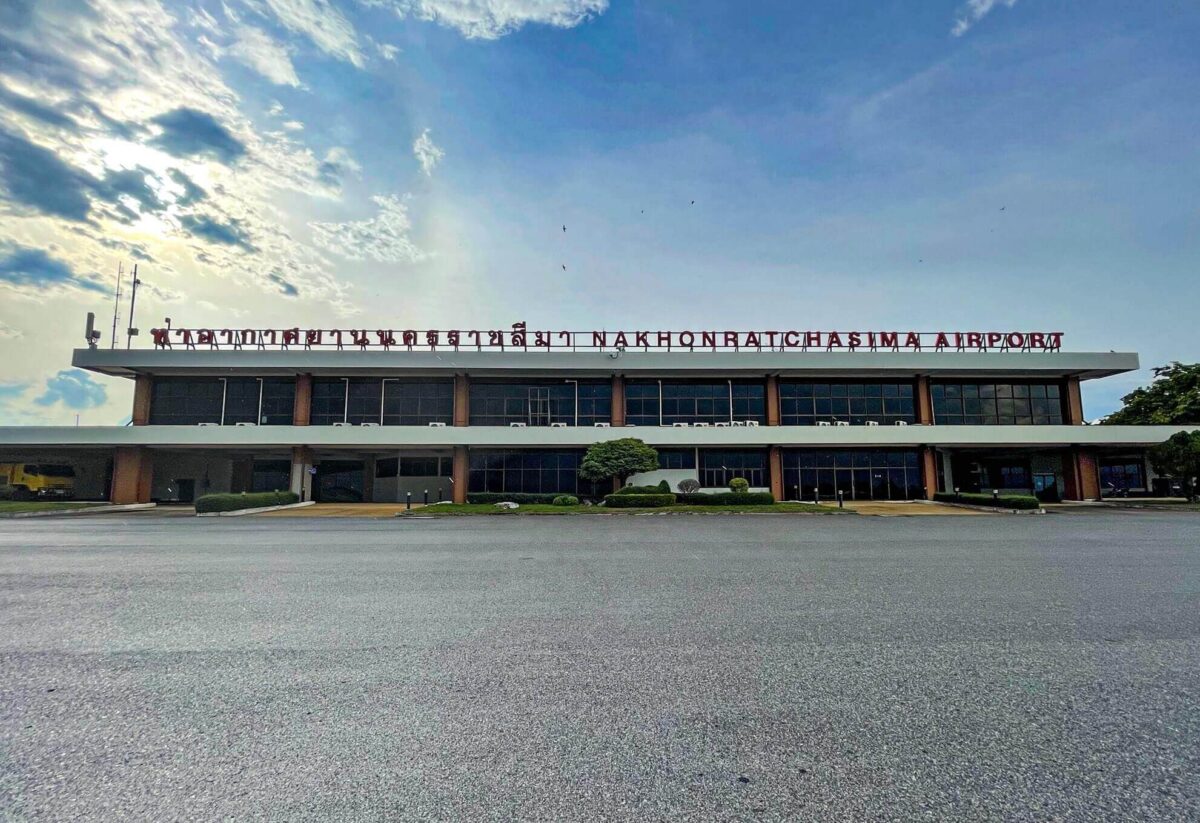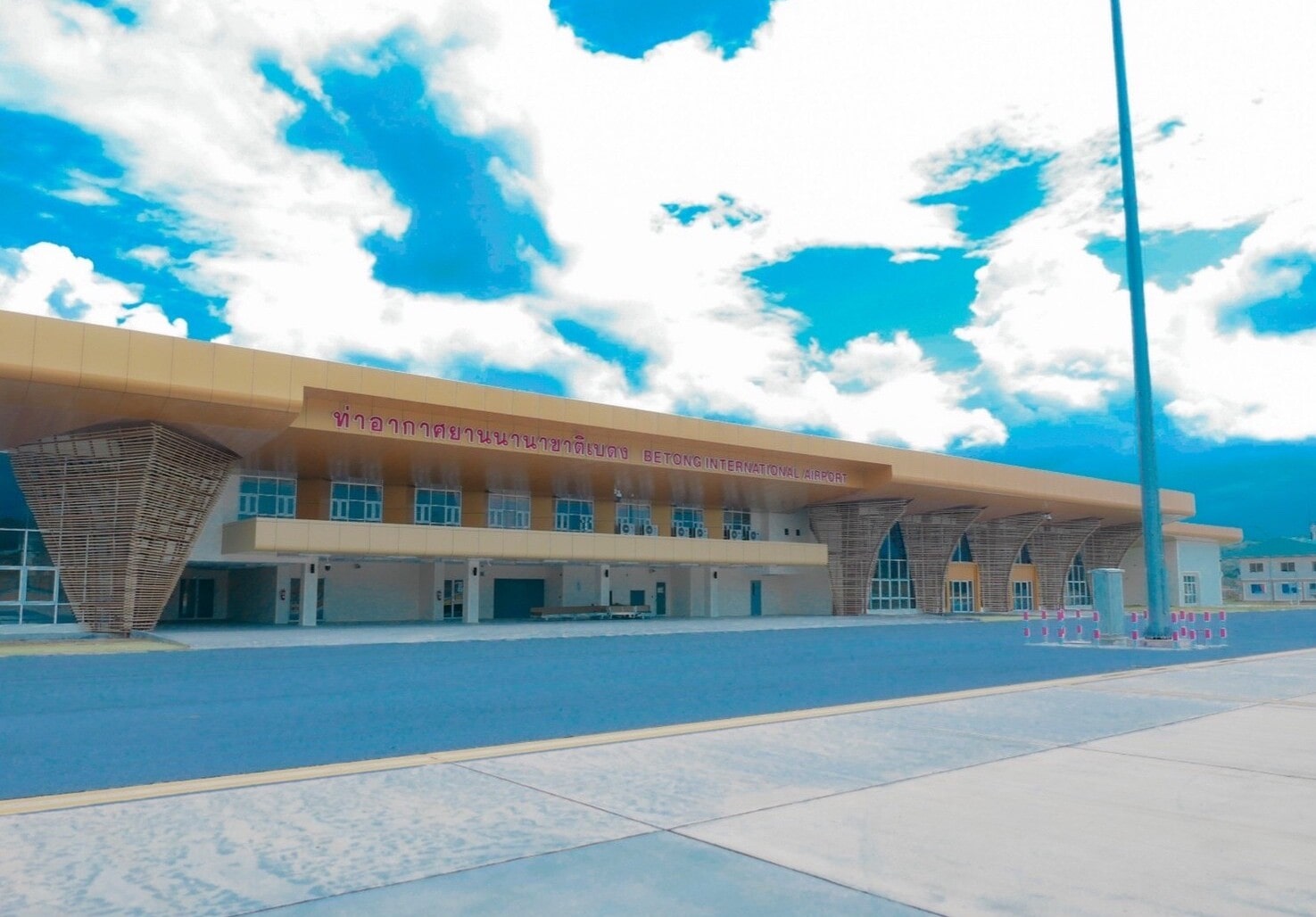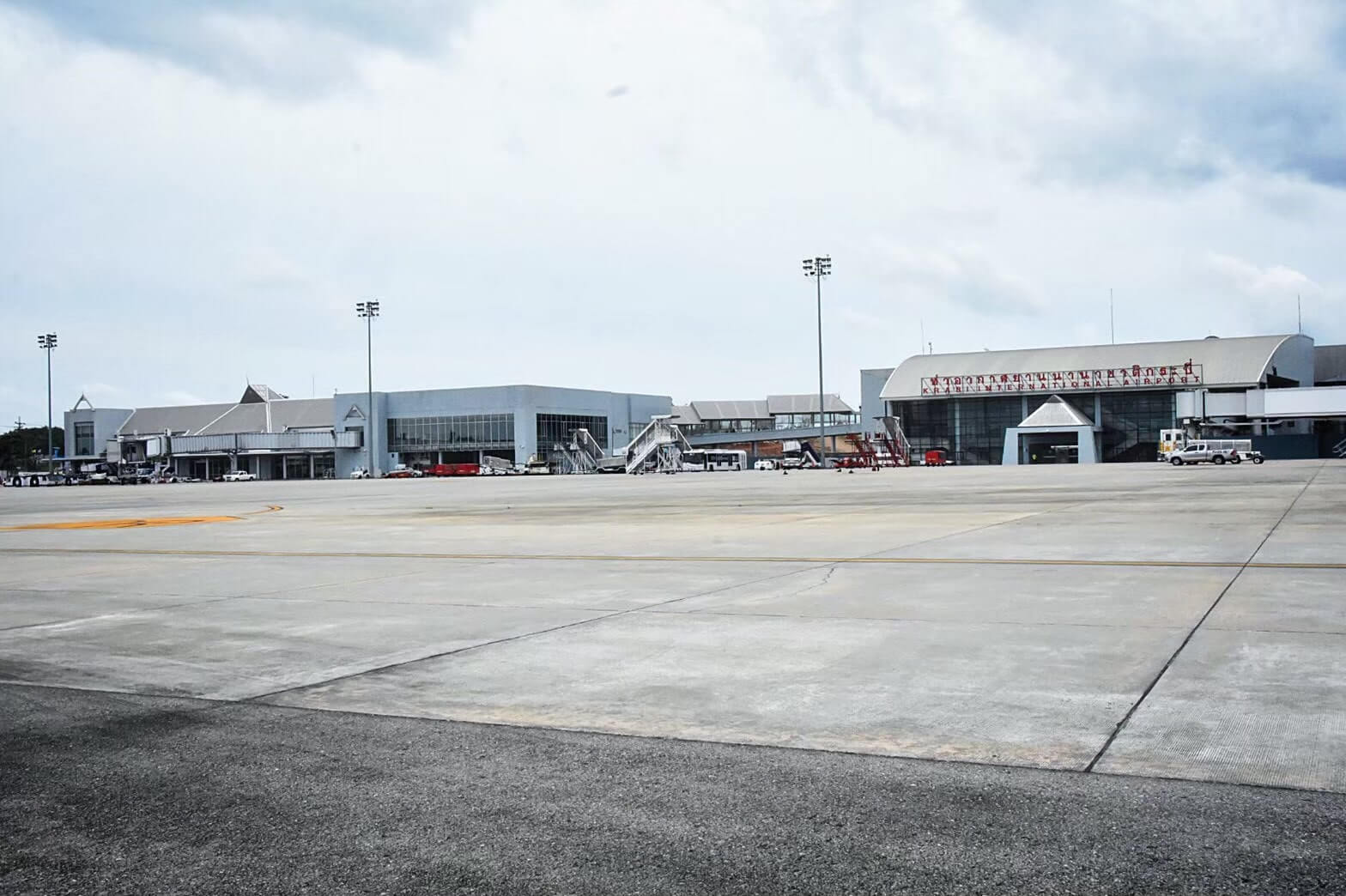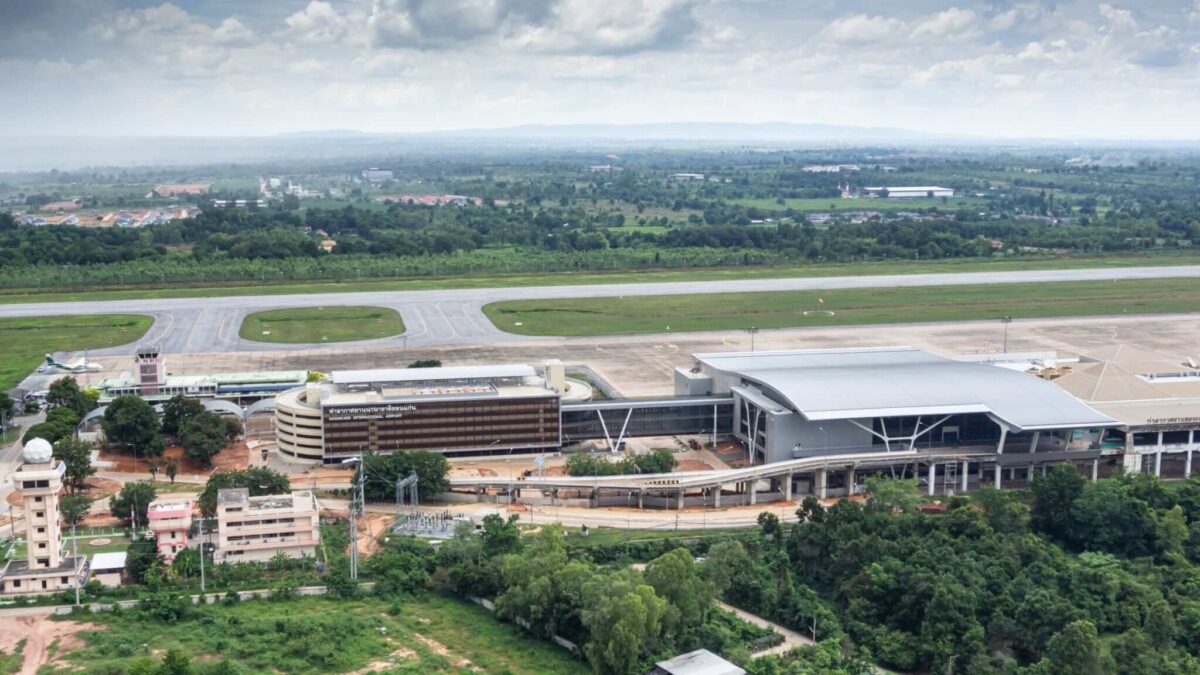Thailand Presses On With Provincial Airport Developments Despite Having Low Or No Commercial Air Traffic
Note: Thai language version of article is lower down หมายเหตุ: บทความภาษาไทยอยู่ด้านล่าง
Thai authorities remain keen to upgrade and expand state-owned provincial airports and even build new ones, even though many existing ones are barely utilised or are ‘ghost airports.’
The Department of Airports (DOA), the agency under the Ministry of Transport in charge of Thailand’s small airports, has shown no sign of delaying, scaling down or scraping its airport development schemes that are costing 27.25 billion baht (US$826 million) between 2018 and 2022.
The government budget earmarked, in the five-year period, improvements to 17 airports owned and operated by the DOA including those in the southern province of Krabi and the northeast provinces of Udon Thani and Buriram.
Meanwhile, it is seeking another 6.79 billion baht in state budget to carry out the expansion of the south’s Chumphon and Ranong airports in the period 2023-2028.
On DOA’s radar screen are two greenfield airport projects in the northeast, namely Mukdahan and Bueng Kan, whose environment impact assessment studies, part of the initial processes required to launch an infrastructure and industrial project, will be carried in the near future. Mukdahan and Bueng Kan are towns on the Thai side of the Mekong River bordering Laos. It is understood that the development of these airports will facilitate travel between Laos and Thailand.
DOA officials tell Smart Aviation Asia Pacific the airport projects are moving ahead unabated in line with the government’s overall transport infrastructure development for the future.
This is despite the fact that passenger demand at many of the DOA’s 29 airports was already low prior to the pandemic which has exasperated the situation.
The outlook for the recovery of domestic air traffic, which DOA’s airports mostly serve, is also not promising, at least over the next couple of years, industry analysts say. It remains unclear when domestic air travel will return to normal.
However, authorities are of the view that domestic flights tend to recover faster than the international services. The Thai government lifted the ban on domestic flights September last year and had eased restrictions for travelling in the country, though they do not say when the traffic will return to pre-COVID levels.
Traffic slump
The relentless coronavirus outbreak has continued to ravage the tourism industry, the backbone of Thailand’s economy, and caused air traffic at DOA airports to plummet in 2021.
In the twelve months of 2021, combined take-offs and landings through DOA airports plunged to 475,632; down 59% from the previous year. Passenger throughput slumped 64% to 43.97 million and cargo dropped 52% to 18,800 tonnes, according to DOA figures.
DOA is the second largest airport operator in Thailand, in terms of passenger throughput, accounting for 17% of 2020’s entire passenger throughput of Thailand’s four licensed civil airport operators, says the Civil Aviation Authority of Thailand (CAAT).
Airports of Thailand (AOT), the majority-state-owned company which runs the country’s six main airports including the Bangkok’s main international gateway Suvarnabhumi Airport, took the lion’s share with 80%. Bangkok Airways, which operates three small airports including Samui International Airport, was third with 2%; while the Royal Thai Navy, which operates Pattaya’s U-tapao International Airport, had 1%.
Ghost Airports
Nineteen of DOA’s 29 airports have scheduled air commercial services, while the rest either only have a handful of flights each week or no commercial flights, leading the public to coin the term ‘ghost airports.’
The DOA airports with on-going commercial flights include,
North: Lampang, Mae Sod, Phitsanulok, Nan and Phrae;
Northeast: Roi Et, Khon Kaen, Udon Thani, Sakhon Nakhon, Ubon Ratchathani, Loei and Nakhon Phanom;
South: Krabi, Trang, Surat Thani, Chumphon, Nakhon Si Thammarat, Narathiwat and Ranong.
Airports with no scheduled flights – but possibly some government and state agency flights – include: Tak, Nakhon Ratchasimi, Pattani, Petchabun, Pai, Mae Sariang, Uttaradit and the newly-built Betong in southernmost Thailand.
In the eyes of critics, many of the DOA’s airports have become a symbol of wasteful state spending and misguided policy based on the whim of politicians to win votes in the name of local development.
These airports with no scheduled flights have not been deserted, but are still staffed and maintained at the DOA’s expense.
The absence of flights at the ‘ghost airports’ is due simply to lack of sufficient air travel demand there.
These smaller airports’ inability to handle larger jet aircraft – such as Boeing 737s or Airbus A320s, which are the main aircraft types that Thai domestic airlines operate – is another drawback.
Only Bangkok Airways and Nok Air have commercial turboprop aircraft that can land at DOA airports that have short runways. But Nok Air’s CEO, Wutthiphum Jurangkool, told Smart Aviation Asia Pacific in November the carrier plans to reduce its Dash 8-400 turboprop fleet to three aircraft from eight as part of its financial turnaround plan.
Meanwhile, Bangkok Airways’ CEO, Puttipong Prasarttong-Osoth, told Smart Aviation Asia Pacific last month that the carrier was due to phase out its last two remaining ATR 72-500s at year-end leaving it with 13 ATR 72-600s. It also operates a fleet of A319s and A320s.
Another reason why some DOA airports remain under served is because of passenger-related issues such as inconvenient flight timetables and airport accessibility, which has led airlines to withdraw after a brief operation.

A good case in point is DOA’s Nakhon Ratchasima Airport, which cost two billion baht and opened in 1997.
Over time, airlines like Thai Airways International, Thai AirAsia and several now-defunct carriers such as Air Andaman, Happy Air, Thai Regional Airline, Kan Air and NexGen Airways tried serving Nakhon Ratchasima Airport but found it unviable.
An absence of commercial flights has also plagued Betong International Airport, DOA’s newest airport located 13 kilometres from Betong city in the southernmost province of Yala.
Airlines have shied away from operating regular flights there, due to uncertainty over passenger demand. The official opening of the two-billion-baht facility, meanwhile has been delayed to sometime in 2022 even though it was due originally due to open in December 2020 and then April 2021.
Betong has a short runway measuring 1,800m (5,906ft) which means only aircraft like De Havilland Aircraft of Canada Dash 8-400s and ATR 72s can land there.

Money-spinners
Before COVID erupted at the end of 2019, all but six of DOA airports were in the red.
The six airports that declared a profit in 2019 in the order of magnitude were: Krabi (375 million baht profit), Udon Thani (48 million baht), Khon Kaen (37 million baht), Surat Thani (29 million baht), Ubon Ratchathani (29 million baht) and Nakhon Si Thammarat (24 million baht).
These six airports have blurred the red ink on other DOA airports with low or no traffic, enabling DOA to post 2.24 billion baht profit in its consolidated balance sheet for 2019.
But it also shows that only a small number of DOA airports have sufficient market demand and are viable.
Works in progress and pipeline
DOA’s cash cow airport, Krabi International Airport, has been undergoing a 5.17 billion-baht expansion spanning to 2025 including a third passenger terminal.
When completed in August 2022, the new Krabi terminal will double the airport’s passenger handling capacity to eight million a year.

Chumphon Airport will get a makeover costing 3.25 billion baht that will be implemented between 2023 and 2027. The outlay will go towards: a passenger terminal expansion to accommodate up to 2.8 million travellers a year from 800,000 currently; and a runway extension to 2,990m from 2,100m so as to serve widebody jets, with 350 seats, flying direct from European and other Asian countries.
There is also the Ranong Airport redevelopment that is estimated to cost 3.53 billion baht and will be implemented in 2023-2028.
Phase one, in 2023-2025, calls for a passenger terminal expansion to accommodate 2.8 million passengers a year, up from the current capacity of 800,000; and a runway extension to 2,400m from 2,000m to cater to 230-seat aircraft flying directly from Asia.
Phase two, in 2025-2028, seeks to further extend the runway to 2,990m and construct a new parallel taxiway.
Other functions
DOA has laid out plans to increase the utilisation of 11 airports that currently have low or no commercial flights.
For instance, Nakhon Ratchasima Airport will become a venue for flying schools, maintenance, repair and overhaul (MRO) companies and aircraft disassembly.
Chumphon, Roi Et, Nakhon Panom, Tak and Phitsanulok will also be promoted as sites for flying schools.
Editor’s comment:
Despite having DOA airports ideally suited to turboprop aircraft and provincial governments keen to develop domestic regional tourism, Thailand has failed to develop a strong regional turboprop operator other than Bangkok Airways and to a lesser extent Nok Air.
There was a small regional airline based in Chiang Mai called Wisdom Airways, but this Cessna Caravan operator went out of business in October 2019 just before the pandemic hit. There was also an ATR turboprop operator based in Chiang Mai called Kan Air but it stopped flying in 2017 and there was a Saab 340 operator based in Bangkok called SGA Airlines that stopped flying in 2014. SGA was marketed under the brand Nok Mini and was an affiliate of Nok Air but had different owners.
Featured photo from DOA shows Khon Kaen Airport in the northeast, which is the third most active among all DOA airports.
ไทยเดินหน้าเดินหน้าพัฒนาท่าอากาศยานระดับจังหวัด แม้ว่าปริมาณการจราจรทางอากาศเชิงพาณิชย์น้อยหรือไม่มีเลย
บุญส่ง โฆษิต 4 ม.ค. 2565
ทางการไทยยังคงกระตือรือร้นที่จะยกระดับ และขยายสนามบินในจังหวัดที่รัฐเป็นเจ้าของ แม้กระทั่งสร้างสนามบินใหม่ ทั้งๆที่สนามบินที่มีอยู่จำนวนมากในปัจจุบันจะแทบไม่ได้ใช้ หรือไม่ก็ร้าง
กรมท่าอากาศยาน (ทย.) ซึ่งเป็นหน่วยงานภายใต้กระทรวงคมนาคมที่รับผิดชอบสนามบินขนาดเล็กของประเทศไทย ไม่ได้แสดงท่าทีว่าจะเลื่อน ลดขนาด หรือยกเลิกการพัฒนาสนามบินมูลค่า 27.25 พันล้านบาท ระหว่างปี 2561 และ 2565
งบประมาณของรัฐบาลในช่วงระยะเวลาห้าปีนั้น ได้ถูกจัดสรรเพื่อปรับปรุงสนามบิน 17 แห่งที่ ทย.เป็นเจ้าของ และดำเนินการ รวมถึงสนามบินในจังหวัดกระบี่ที่ภาคใต้ และ จังหวัดอุดรธานี กับบุรีรัมย์ ทางตะวันออกเฉียงเหนือ
ในขณะเดียวกัน ทย.กำลังของบประมาณของรัฐอีก 6.79 หมื่นล้านบาท เพื่อดำเนินการขยายสนามบินชุมพร และระนองที่ภาคใต้ในช่วงปี 2566-2571
ทย.ยังมีโครงการสร้างสนามบินใหม่อีกสองแห่งในภาคตะวันออกเฉียงเหนือ ได้แก่ มุกดาหารและบึงกาฬ ซึ่งกำลังจะมีการศึกษาการประเมินผลกระทบสิ่งแวดล้อม อันเป็นส่วนหนึ่งของกระบวนการเริ่มต้นที่จำเป็นในการเปิดโครงสร้างพื้นฐาน และโครงการอุตสาหกรรม ในอนาคตอันใกล้นี้
มุกดาหารและบึงกาฬ เป็นเมืองริมแม่น้ำโขงที่มีพรมแดนติดกับประเทศลาว เป็นที่เข้าใจกันว่าการพัฒนาท่าอากาศยานเหล่านี้จะอำนวยความสะดวกในการเดินทางระหว่างลาวและไทย
เจ้าหน้าที่ ทย.บอกกับ Smart Aviation Asia Pacific ว่าโครงการสนามบินเหล่านี้กำลังดำเนินไปข้างหน้าอย่างไม่ลดละ เพื่อให้สอดคล้องกับการพัฒนาโครงสร้างพื้นฐานด้านการขนส่งโดยรวมของรัฐบาลในอนาคต
ซึ่งแม้ว่าความต้องการของผู้โดยสารที่สนามบิน 29 แห่งที่ ทย. ดำเนินการอยู่ยังต่ำอยู่แล้วก่อนเกิดโรคระบาด ที่ทำให้สถานการณ์เลวร้ายลงอีก
นักวิเคราะห์อุตสาหกรรมกล่าวว่าแนวโน้มการฟื้นตัวของการจราจรทางอากาศภายในประเทศ ซึ่งสนามบินของ ทย. ส่วนใหญ่ให้บริการนั้น ก็ไม่น่าจะเป็นไปได้เช่นกัน อย่างน้อยก็ในอีกสองสามปีข้างหน้า และยังไม่ชัดเจนว่าการเดินทางทางอากาศภายในประเทศจะกลับมาเป็นปกติเมื่อใด
อย่างไรก็ตาม ทางการเห็นว่าเที่ยวบินภายในประเทศมีแนวโน้มฟื้นตัวได้เร็วกว่าบริการระหว่างประเทศ ส่วนหนึ่งเป็นผลจากที่รัฐบาลไทยยกเลิกคำสั่งห้ามเที่ยวบินภายในประเทศเมื่อเดือนกันยายนปีที่แล้ว และผ่อนปรนข้อจำกัดในการเดินทางภายในประเทศ แต่พวกเขาไม่ได้บอกว่าการจราจรจะกลับสู่ระดับก่อนเกิดโควิด-19 เมื่อใด
การจราจรทางอากาศตกต่ำ
การระบาดของโคโรนาไวรัสอย่างไม่หยุดยั้งได้ทำลายอุตสาหกรรมการท่องเที่ยว อันเป็นกระดูกสันหลังของเศรษฐกิจของประเทศไทย อย่างต่อเนื่อง และทำให้การจราจรทางอากาศที่ ทย. ดำเนินการ ลดลงในปีที่แล้ว
ตามตัวเลขของ ทย.ในช่วงสิบสองเดือนของปี 2564 การขึ้นและลงเครื่องบินที่ท่าอากาศยานของ ทย. รวมกันลดลงเหลือ 475,632 ครั้ง ลดลง 59% จากปีก่อนหน้า ขณะที่ปริมาณการขนส่งผู้โดยสารลดลง 64% เป็น 43.97 ล้าน และ สินค้า พัสดุ ลดลง 52% เป็น 18,800 ตัน
ตามข้อมูลของสำนักงานการบินพลเรือนแห่งประเทศไทย ทย.เป็นผู้ให้บริการสนามบินรายใหญ่เป็นอันดับสองของประเทศไทยในแง่ของปริมาณผู้โดยสาร ซึ่งคิดเป็น 17% ของปริมาณผู้โดยสารทั้งหมดในปี 2563 ของผู้ประกอบการสนามบินพลเรือนที่ได้รับใบอนุญาตสี่รายของประเทศไทย
บริษัทท่าอากาศยานไทย (ทอท.) ซึ่งเป็นบริษัทรัฐวิสาหกิจที่บริหารท่าอากาศยานหลักหกแห่งของประเทศ รวมทั้งท่าอากาศยานนานาชาติสุวรรณภูมิ ครองส่วนแบ่ง 80% บางกอกแอร์เวย์ส ซึ่งมีสนามบินขนาดเล็กสามแห่งรวมถึงสนามบินนานาชาติสมุยเป็นอันดับสามด้วย 2% ในขณะที่กองทัพเรือไทยซึ่งดำเนินการท่าอากาศยานนานาชาติอู่ตะเภามี 1%
สนามบินผี
สนามบิน 19 แห่งจากทั้งหมด 29 แห่งของ ทย.ให้บริการเชิงพาณิชย์ทางอากาศ ในขณะที่สนามบินอื่นๆ อาจมีเที่ยวบินเพียงไม่กี่เที่ยวต่อสัปดาห์ หรือไม่มีเที่ยวบินเชิงพาณิชย์เลย ส่งผลให้ประชาชนทั่วไปขนานนามว่า “สนามบินผี”
สนามบินของ ทย.ที่ยังคงมีเที่ยวบินเชิงพาณิชย์ต่อเนื่อง ได้แก่
ภาคเหนือ: ลำปาง แม่สอด พิษณุโลก น่าน และแพร่
ภาคตะวันออกเฉียงเหนือ: ร้อยเอ็ด ขอนแก่น อุดรธานี สกลนคร อุบลราชธานี เลย และนครพนม
ภาคใต้: กระบี่ ตรัง สุราษฎร์ธานี ชุมพร นครศรีธรรมราช นราธิวาส และระนอง
สนามบินที่ไม่มีเที่ยวบินประจำเลย แต่อาจให้บริการเที่ยวบินของรัฐบาล และหน่วยงานของรัฐ ได้แก่ ตาก นครราชสีมา ปัตตานี เพชรบูรณ์ ปาย แม่สะเรียง อุตรดิตถ์ และ เบตง ที่เพิ่งสร้างเสร็จใหม่ทางตอนใต้สุดของประเทศไทย
ในสายตาของนักวิจารณ์ สนามบินหลายแห่งของ ทย.ได้กลายเป็นสัญลักษณ์ของการใช้จ่ายอย่างสิ้นเปลืองของรัฐ และนโยบายที่ชักนำไปในทางที่ผิดของนักการเมืองเพื่อหาเสียง ในนามของการพัฒนาท้องถิ่น
สนามบินเหล่านี้ที่ไม่มีเที่ยวบินประจำยังไม่ถูกทิ้งร้าง แต่ยังคงมีพนักงานและบำรุงรักษาโดยเป็นค่าใช้จ่ายของ ทย.
การไม่มีเที่ยวบินที่ ‘สนามบินผี’ เกิดจากการขาดความต้องการเดินทางทางอากาศที่เพียงพอที่นั่น
สนามบินขนาดเล็กเหล่านี้ไม่สามารถรองรับเครื่องบินเจ็ทขนาดใหญ่ได้ เช่น โบอิ้ง 737 หรือแอร์บัส A320 ซึ่งเป็นเครื่องบินประเภทหลักที่สายการบินภายในประเทศของไทยให้บริการ เป็นข้อเสียอีกประการหนึ่ง
มีเพียงบางกอกแอร์เวย์ส และนกแอร์เท่านั้นที่มีเครื่องบินใบพัดเชิงพาณิชย์ที่สามารถลงจอดที่สนามบินของ ทย.ที่มีทางวิ่งสั้น
อย่างไรก็ตาม วุฒิภูมิ จุฬางกูร ประธานเจ้าหน้าที่บริหารของนกแอร์ บอกกับ Smart Aviation Asia Pacific เมื่อเดือนพฤศจิกายนว่า สายการบินมีแผนที่จะลดฝูงบินใบพัด Dash 8-400 เหลือ สามลำจากเดิม แปดลำ ซึ่งเป็นส่วนหนึ่งของแผนฟื้นฟูทางการเงิน
ในขณะเดียวกัน พุฒิพงศ์ ปราสาททองโอสถ ซีอีโอของสายการบินบางกอกแอร์เวย์ส บอกกับ Smart Aviation Asia Pacific เร็วๆนี้ว่า สายการบินมีกำหนดจะเลิกใช้ ATR 72-500 สองลำสุดท้ายที่เหลืออยู่เมื่อสิ้นปีที่แล้ว โดยเหลือ ATR 72-600 จำนวน 13 ลำ นอกจากนี้ยังให้บริการฝูงบิน A319 และ A320
อีกเหตุผลหนึ่งที่สนามบินของ ทย. บางแห่งยังคงให้บริการต่ำกว่าความสามารถ นั้นเป็นเพราะปัญหาที่เกี่ยวข้องกับผู้โดยสาร เช่น ตารางเที่ยวบินที่ไม่สะดวก และการเข้าถึงสนามบิน ซึ่งทำให้สายการบินต้องถอนตัวหลังจากดำเนินการช่วงสั้นๆเท่านั้น

สนามบินนครราชสีมายังคงว่างเสียส่วนใหญ่ในช่วงเกือบสองทศวรรษที่ดำรงอยู่ (ภาพ:ทย.)
ตัวอย่างที่ดีคือสนามบินนครราชสีมาของ ทย. ซึ่งก่อสร้างด้วยมูลค่าสองพันล้านบาท และเปิดดำเนินการในปี 2540
เมื่อกาลเวลาผ่านไป สายการบินต่างๆ เช่น การบินไทย ไทยแอร์เอเชีย และสายการบินที่เลิกกิจการไปแล้วหลายราย เช่น แอร์อันดามัน แฮปปี้แอร์ ไทยรีเจียนัลแอร์ไลน์ กานต์แอร์ และ นิวเจนแอร์เวย์ พยายามให้บริการสนามบินนครราชสีมา แต่ต้องถอนตัวไปเพราะไม่คุ้มค่า
การไร้เที่ยวบินได้ก่อให้เกิดภัยพิบัติกับท่าอากาศยานนานาชาติเบตง สนามบินแห่งใหม่ล่าสุดของ ทย. ที่อยู่ห่างจากเมืองเบตง 13 กิโลเมตรในจังหวัดยะลา
สายการบินต่างๆได้เมินให้เที่ยวบินปกติ เนื่องจากความต้องการผู้โดยสารยังไม่แน่นอน
การเปิดอย่างให้บริการอย่างเป็นทางการของสนามบินเบตง มูลค่าสองพันล้านบาท ถูกเลื่อนออกไปเป็นเวลาใดเวลาหนึ่งในปี 2565 จากกำหนดการเดิม ในเดือนธันวาคม 2563 และเมษายน 2564
สนามบินเบตงมีทางวิ่งสั้นขนาด 1,800 เมตร (5,906 ฟุต) ซึ่งหมายความว่ามีเพียงเครื่องบินอย่าง De Havilland Aircraft ของ Canada Dash 8-400 และ ATR 72 เท่านั้นที่สามารถลงจอดได้

ท่าอากาศยานเบตงเข้าร่วมชมรม ‘สนามบินผี‘ ของ ทย. (ภาพ: ทย.)
สนามบินที่มีกำไร
ก่อนที่โควิดจะปะทุในช่วงปลายปี 2562 มีสนามบินเพียงหกแห่งจากทั้งหมดของ ทย. ที่มีผลประกอบการกำไรในปี 2562
เรียงตามลำดับความสำคัญดังนี้ กระบี่ (กำไร 375 ล้านบาท) อุดรธานี (48 ล้านบาท) ขอนแก่น (37 ล้านบาท) สุราษฎร์ธานี (29 ล้านบาท) อุบลราชธานี (29 ล้านบาท) และนครศรีธรรมราช (24 ล้านบาท)
สนามบินทั้งหกแห่งนี้ได้กลบตัวเลขสีแดงในงบดุลของสนามบิน ทย. อื่นๆ ที่มีการจราจรน้อยหรือไม่มีเลย ทำให้ ทย. สามารถมีกำไร 2.24 พันล้านบาทในงบดุลรวมสำหรับปี 2562
แต่นั่นยังแสดงให้เห็นว่าสนามบิน ทย. เพียงไม่กี่แห่งเท่านั้นที่มีความต้องการของตลาดเพียงพอ และเป็นไปได้ทางเศรษฐศาสตร์อยู่
โครงการระหว่างดำเนินการและในแผน
สนามบินนานาชาติกระบี่ ที่เป็นแหล่งรายได้ใหญ่ที่สุดของ ทย. ได้รับการขยาย ต่อเนื่องถึง ปี 2568 ด้วยงบ 5.17 พันล้านบาท รวมทั้งอาคารผู้โดยสารหลังที่สาม
เมื่อแล้วเสร็จในเดือนสิงหาคม 2565 อาคารผู้โดยสารแห่งใหม่ของกระบี่ จะเพิ่มขีดความสามารถในการรองรับผู้โดยสารของสนามบินเป็นสองเท่า เป็นแปดล้านคนต่อปี

อากาศยานนานาชาติกระบี่เป็นสนามบินที่มีผลงานดีที่สุดของ ทย. และการลงทุนที่ดีที่สุดของงบประมาณแผ่นดิน (ภาพ: ทย.)
สนามบินชุมพรจะได้รับการปรับปรุงใหม่ด้วยมูลค่า 3.25 พันล้านบาท ซึ่งจะดำเนินการระหว่างปี 2566 ถึง 2570 ค่าใช้จ่ายจะใช้เพื่อ การขยายอาคารผู้โดยสารเพื่อรองรับนักเดินทางให้ได้ถึง 2.8 ล้านคนต่อปี จาก 800,000 คนในปัจจุบัน และส่วนต่อขยายทางวิ่งจาก 2,100 เป็น 2,990 เมตร เพื่อให้บริการเครื่องบินเจ็ตลำตัวกว้าง 350 ที่นั่ง บินตรงจากประเทศในยุโรป และประเทศอื่นๆ ในเอเชีย
นอกจากนี้ยังมีการปรับปรุงสนามบินระนองซึ่งคาดว่าจะมีมูลค่า 3.53 พันล้านบาทและจะดำเนินการระหว่างปี 2566-2571
โดยระยะที่หนึ่งของการพัฒนา ในปี 2566-2568 ให้มีการขยายอาคารผู้โดยสารเพื่อรองรับผู้โดยสาร 2.8 ล้านคนต่อปี เพิ่มขึ้นจากความสามารถปัจจุบันที่ 800,000 คน และขยายทางวิ่งเป็น 2,400 เมตร จาก 2,000 เมตร เพื่อรองรับเครื่องบิน 230 ที่นั่งที่บินตรงจากเอเชีย
ระยะที่สอง ในปี 2568-2571 จะขยายทางวิ่งต่อไปเป็น 2,990 เมตร และสร้างทางขับขนานใหม่
ใช้ประโยชน์ในด้านอื่นๆ
ทย. ได้วางแผนเพิ่มการใช้ประโยชน์ในด้านอื่นๆของ สนามบิน 11 แห่งซึ่งปัจจุบันมีเที่ยวบินเชิงพาณิชย์น้อยมากหรือไม่มีเลย
ตัวอย่างเช่น สนามบินนครราชสีมาจะกลายเป็นสถานที่สำหรับโรงเรียนการบิน กิจการซ่อมบำรุง ซ่อมแซมและยกเครื่อง (MRO) และการถอดแยกชิ้นส่วนเครื่องบิน
สนามบินชุมพร ร้อยเอ็ด นครพนม ตาก และพิษณุโลก จะได้รับการส่งเสริมให้เป็นโรงเรียนการบินด้วย
ความคิดเห็นของบรรณาธิการ:
แม้จะมีสนามบินของ ทย. ที่เหมาะสมอย่างยิ่งกับเครื่องบินใบพัดเครื่องบิน และตอบสนองกับรัฐบาลระดับจังหวัดที่กระตือรือร้นที่จะพัฒนาการท่องเที่ยวภายในประเทศในภูมิภาค แต่ประเทศไทยก็ล้มเหลวในการพัฒนาผู้ให้บริการเครื่องบินใบพัดประจำภูมิภาคที่แข็งแกร่งนอกเหนือจากบางกอกแอร์เวย์ส และนกแอร์ในระดับที่น้อยกว่า
มีสายการบินระดับภูมิภาคขนาดเล็กในเชียงใหม่ชื่อ วิสดอม แอร์เวยส์ แต่ผู้ให้บริการเครื่องบินแบบ Cessna Caravan รายนี้ต้องเลิกกิจการในเดือนตุลาคม 2562 ก่อนเกิดโรคระบาด
นอกจากนี้ยังมีผู้ให้บริการเครื่องบินใบพัดแบบ ATR ในจังหวัดเชียงใหม่ที่เรียกว่า กานต์แอร์ แต่ได้หยุดบินในปี 2560
และยังมีผู้ให้บริการด้วยเครื่องบิน Saab 340 ในกรุงเทพฯ ชื่อ SGA Airlines ซึ่งหยุดบินในปี 2014 โดย SGA ดำเนินการ ภายใต้แบรนด์ Nok Miniที่เป็นบริษัทในเครือของนกแอร์ แต่มีเจ้าของต่างกัน
ภาพหลักแสดงให้เห็นท่าอากาศยานขอนแก่นในภาคตะวันออกเฉียงเหนือ ซึ่งเป็นของท่าอากาศยานที่มีปริมาณการจราจรมากเป็นอันดับสามของสนามบินของ ทย. ทั้งหมด
—–

